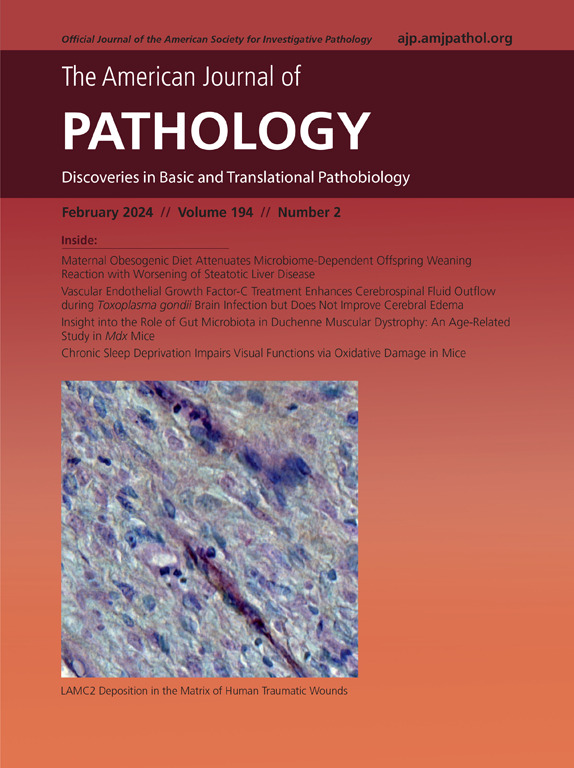Caspase-1 Inhibition Ameliorates Photoreceptor Damage Following Retinal Detachment by Inhibiting Microglial Pyroptosis
IF 4.7
2区 医学
Q1 PATHOLOGY
引用次数: 0
Abstract
Retinal detachment (RD) is a sight-threatening condition that occurs in several retinal diseases. Microglia that reside in retina are activated after RD and play a role in the death of photoreceptor cells. The involvement of microglial pyroptosis in the early pathological process of RD is still unclear. VX-765, an inhibitor of caspase-1, may exert neuroprotective effects by targeting microglial pyroptosis in nervous system disease; however, whether it plays a role in RD is uncertain. This study detected and localized pyroptosis to specific cells by immunofluorescence co-staining and flow cytometry in rat RD models. The majority of gasdermin D N-terminal (GSDMD-N)-positive cells exhibited IBA1-positive or P2RY12-positive microglia in the early stage of RD, indicating the pyroptosis of microglia. Administration of VX-765 shifted the microglia phenotype from M1 to M2, inhibited microglial migration toward the outer nuclear layer (ONL) post-RD, and most importantly, inhibited microglial pyroptosis. The thickness of ONL increased with VX-765 administration, and the photoreceptors were more structured and orderly under hematoxylin and eosin staining and transmission electron microscopy, revealing the protective effects of VX-765 on photoreceptors. Overall, this study demonstrated that inflammation induced by pyroptosis of microglia is the early pathological process of RD. VX-765 may serve as a candidate therapeutic approach for the treatment of RD by targeting microglia.
抑制Caspase-1可通过抑制小胶质细胞凋亡改善视网膜脱离后的光感受器损伤
视网膜脱离(RD)是一种危及视力的疾病,在多种视网膜疾病中都会发生。RD 发生后,视网膜中的小胶质细胞会被激活,并参与感光细胞的死亡。小胶质细胞脓毒症参与 RD 早期病理过程的情况尚不清楚。有研究表明,Caspase-1抑制剂VX-765可通过靶向神经系统疾病中的小胶质细胞热凋亡发挥神经保护作用,但其在RD中是否发挥作用尚不确定。本研究通过免疫荧光联合染色和流式细胞术检测了大鼠 RD 模型中特定细胞的热凋亡并将其定位。在 RD 早期,大多数 gasdermin D N 末端(GSDMD-N)阳性细胞表现为 IBA1 阳性或 P2RY12 阳性的小胶质细胞,这表明小胶质细胞发生了热凋亡。服用VX-765可使小胶质细胞表型从M1转变为M2,抑制小胶质细胞在RD后向核外层(ONL)迁移,最重要的是抑制了小胶质细胞的热凋亡。服用VX-765后,核外层厚度增加,在苏木精、伊红染色和透射电子显微镜下,光感受器的结构更加清晰有序,这揭示了VX-765对光感受器的保护作用。总之,本研究表明,小胶质细胞热解诱导的炎症是 RD 的早期病理过程。通过靶向小胶质细胞,VX-765 可作为治疗 RD 的候选疗法。
本文章由计算机程序翻译,如有差异,请以英文原文为准。
求助全文
约1分钟内获得全文
求助全文
来源期刊
CiteScore
11.40
自引率
0.00%
发文量
178
审稿时长
30 days
期刊介绍:
The American Journal of Pathology, official journal of the American Society for Investigative Pathology, published by Elsevier, Inc., seeks high-quality original research reports, reviews, and commentaries related to the molecular and cellular basis of disease. The editors will consider basic, translational, and clinical investigations that directly address mechanisms of pathogenesis or provide a foundation for future mechanistic inquiries. Examples of such foundational investigations include data mining, identification of biomarkers, molecular pathology, and discovery research. Foundational studies that incorporate deep learning and artificial intelligence are also welcome. High priority is given to studies of human disease and relevant experimental models using molecular, cellular, and organismal approaches.

 求助内容:
求助内容: 应助结果提醒方式:
应助结果提醒方式:


